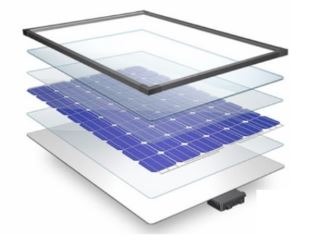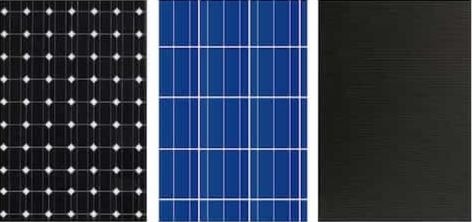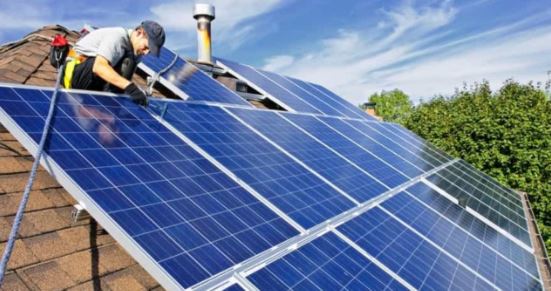What is a solar panel?
A solar panel combines an average of 60 solar cells that convert the sun’s rays into electrical energy and ensure optimal power generation. Several solar panels are connected in series or in parallel to set up a solar system.
How does a photovoltaic system work?
Photovoltaic systems use the photoelectric effect to convert light into electrical energy. The classic solar cell consists of semiconductor silicon. This metal has the special property of being charged by the electromagnetic radiation of sunlight. The charge is bundled by a layering system and converted into usable electricity.
Construction of a solar panel
The solar cells of a PV module consist of different layers, which are all important for energy production but have very different tasks.
The front glass (ESG) forms the first layer and protects against temperature changes and other external influences such as snow loads or branches that could fall on a solar panel. Normally a 4mm thick front glass is used.
Underneath is a plastic layer made of ethylene vinyl acetate (EVA) or a cast resin layer. This layer makes the solar panel waterproof and protects against moisture ingress.
The individual solar cells are built into the third layer and interconnected with solder strips. A plastic layer of ethylene vinyl acetate (EVA) or cast resin is again attached under the solar cells to ensure water protection in both directions.
Now a plastic film is used, which consists of polyvinyl fluoride. Alternatively, a simple glass plate is used. An aluminium frame ensures that the upper layers are held in place. This also makes it easier to attach to the roof later.
What types of solar panels are there?
The different types of solar modules differ mainly in the material of the solar cells.
Monocrystalline solar panels and polycrystalline solar panels are among the most popular and most common solar cells. Due to their special properties, there are also thin-film and CIGS modules, which are less common in installing private photovoltaic systems.
The latest innovations in the solar panel market
PV modules with half-cell technology are a relatively new invention that aims to increase efficiency by halving the number of solar cells. In tests conducted, a solar module with 144 half-cells delivered five per cent more electricity than a module with 72 full cells.
The changed cell arrangement is particularly effective when there is shading because the solar cells can operate better on the non-shaded side of the module.
Glass-glass modules are characterized, above all, by their long service life. Because glass is used on the front and back of the solar module, it can be exposed to high mechanical loads and has low degradation behaviour.
How much does a solar panel cost?
The price per solar panel is directly related to the performance. While the cheap ones cost less money per solar panel, the expensive ones have the advantage of being more efficient. This means you need fewer cells to achieve your desired performance.
Monocrystalline solar panels are very complex to manufacture and therefore relatively expensive. Polycrystalline cells, on the other hand, are easier to produce and, therefore, cheaper. The thin-film cells are the cheapest. However, these also have the lowest performance.
According to Fraunhofer ISE, solar modules only make up around a third of the total price of a solar system. It should be noted that prices can fluctuate greatly, as they are subject to many factors, such as performance, manufacturer, origin and market situation.
Components and function of a solar panel system
A solar panel consists of several connected solar cells responsible for energy conversion. The solar cells of the PV module then produce electricity as soon as light rays hit them. The photons of the sun’s rays release electrons in the material of the solar cells, which then flow as the direct current through the wiring.
Because solar cells convert the sun’s rays into direct current, but the house electricity is used as alternating current, the following step is essential: The direct current produced flows to the inverter pure sine wave, where the direct current is converted into the alternating current before it is fed into the house power grid.
Excess solar power is fed into the public power grid, for which the household receives a feed-in tariff. Under certain circumstances, there may be a bottleneck in power generation by the solar panel in the winter months. In this case, the household then draws additional electricity from the public grid.
One way to reduce external power consumption and electricity bills is to add a power storage unit to the system. Because a solar system with lithium ion solar battery allows excess green electricity to be stored during the day.
Here you will find an overview of the various solar power storage systems with their advantages and disadvantages.
You can set up a permanent and self-sufficient off grid solar system by installing storage. The special thing about a stand-alone solar system is that there is no connection to the public power grid. Your household would then be supplied exclusively with solar energy.
Then you would be completely self-sufficient and independent of the electricity provider and the rising electricity prices. In most cases, however, it is advisable to keep the connection to the public electricity grid to fall back on it in the moment of an emergency.
How do you attach a solar panel?
When installing the solar modules, they are attached to a metal frame above the roof tiles. U-shaped roof hooks are used to fix the metal frame to the roof. The frame is screwed to the rafters under the roof tiles.
A solar panel can not only work with sun rays; Other light sources can also be used to generate electricity. This is due to the photons contained in laser beams.
It is often wrongly thought that the amount of electricity produced has something to do with the sun’s heat. However, heat reduces the performance of a solar panel and is more harmful than helpful. The decisive factor is solely the intensity of the solar radiation and, thus, the number of photons that hit the cells.
What is the power of a solar module?
On average, solar modules have an output of 50 W to 350 W. Watt is the maximum energy output the module can produce. Depending on the material of the module (monocrystalline, polycrystalline or thin film), the modules can have different efficiencies. The higher the efficiency of the solar module, the higher its performance. And the higher the power, the fewer modules are required.
What you should consider when buying a solar panel
Are you thinking about buying a solar system or renting a solar system? Here are the key points to consider in the decision-making process.
1. How many solar panels do you need?
An average PV system in this country is 4 to 10 kW for a single-family house.
The following factors determine the rated output of your system:
- The power consumption
- The proportion of electricity consumption that is to be covered by the PV system
- Feed-in system or island system?
- The weather and light conditions
Your power consumption should serve as a starting point to estimate your system’s required performance. Here you can calculate your electricity consumption.
If you would like to completely cover your electricity consumption with the electricity you generate yourself, you can work with the following reference values:
One kW covers a maximum of around 1000 kWh per year. Because hours of sunshine in Germany are very irregular, it is better to install a system whose maximum output produces significantly more electricity than your power consumption. So if your annual consumption is 3000 kWh, your PV system should have an output of at least 3.5 kW or 4 kW. If you calculate with 6 square meters per kW, you need a total of 21 – 24 square meters of roof area for this project.
When thinking about an island system, you need a lot more power. Here, the power requirement is covered completely autonomously, without additional, external power. Because stand-alone systems are not connected to the public power grid, you will not receive any feed-in tariffs for stand-alone systems. Here you can find out everything about off-grid solar power systems.
If you live in very cloudy regions where the sun hardly shines, you can produce less energy with the same nominal power. Poor alignment or shading can lead to further deficits. You can find out more about the influence of shading and weather here.
2. How much space do you have on your roof?
Once you have the performance you want in mind, it’s time to start thinking about how to make the vision a reality. A limiting factor is the size of your roof. Strictly speaking, it is about the roof area suitable for installing solar panels.
As you read in the previous section, solar cell types differ in efficiency. If you have a sufficiently large roof area to generate the desired output, you can, for example, use the cheaper polycrystalline solar panel modules (6-7 sqm / kW). If you have less space, you may use the more expensive but more efficient monocrystalline modules (5-6qm / kW).
3. Are there limiting factors affecting the solar modules?
Factors such as orientation, shading, climate and statics of the roof can also have an impact on the purchase decision. For example, if your roof is made of thatch, slate or sheet metal, it is usually not possible to attach solar modules.
A PV system is often not a good option if your roof cannot support a lot of weight for stability reasons. Alternatively, thin-film modules, which are very light, can be installed if necessary.
If your roof doesn’t face south or you have shading, you usually need more panels to cover the desired amount of electricity.
4. Do you attach particular importance to the optics?
In recent years, aesthetics has played a major role in buying. Black or dark solar panels are becoming increasingly popular. Black solar modules, also known as “All Black”, not only consist of a dark frame, but the cells themselves and the backing film are also black.
Basically, black PV modules cost a little more than conventional blue modules. Nevertheless, it is worth comparing several offers. There are sometimes special offers due to overcapacity or model changes.
5. What budget do you have available?
In the last step of the buying process, you should see to what extent your ideas correspond to your budget. The price per module is currently between €120 and €340. However, there are seasonal price fluctuations. Due to falling demand from China, solar module prices fall slightly in the winter months. Here you can find out everything about the costs of solar systems.
It is helpful to draw up an overall cost plan for purchasing your solar system since you should consider other fixed costs such as inverters, mounting frames and installation costs when purchasing the solar cells. To calculate the total costs based on the desired nominal power, you can calculate with a value between 1,100 and 1,300 € per kWp. You can find everything about a system: photovoltaic information, prices and tips in 2022.
Is your liquidity insufficient to pay for a PV system in the desired form? Nowadays, in addition to cheap loans and funding opportunities, there are innovative financing models such as B. the rent.
The advantage of the rental model is that you benefit from the advantages of a solar powered generator system from day one. Still, the costs are only incurred in instalments over a fixed period. The monthly instalments are often even lower than the electricity prices that would otherwise be paid to the electricity supplier without a PV system.
The perfect location for a solar panel
A sunny climate with few clouds and fog is ideal. The absence of shadows, such as trees or buildings, also plays a major role. You should not underestimate the optimal orientation to the south and the perfect installation angle of 30 degrees.
Roof surfaces are usually not directly south-facing, and the inclination angle is rarely exactly 30 degrees. Flat roofs are often more suitable because here, you can select and fine-tune the angle and alignment with the utmost precision. As already mentioned, high heat has a negative effect on the performance of a solar panel. Therefore, lower temperatures and some wind are very good for optimizing and maintaining the efficiency of a solar system.
In addition, attention should be paid to the possibility of contamination by sand or earth. The coverage of the solar panel by snow is just as bad. This should be able to slide off easily and not accumulate under the solar panel.




